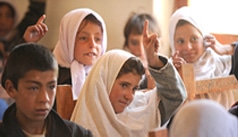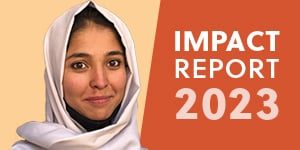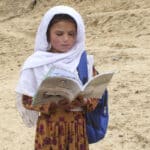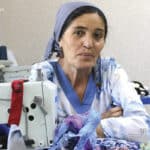Celebrating Our Birthday: The Pioneer Fund a Next Generation Idea
Today is a big day for CAI – we’re celebrating 21 years of providing education to some of the most remote areas of Pakistan, Afghanistan, and Tajikistan. We’re marking this occasion with a huge announcement that honors our past as pioneers of innovation and looking to the future needs of the people we serve. Please welcome the Pioneer Fund.
The Pioneer Fund is a chance for us to get back to our roots – to try new ideas that push forward the opportunities for education in paths no one thought possible. It will empower our in-country partners to create effective new projects to meet a changing demand for education.
Jim Thaden, executive director of Central Asia Institute says, “CAI has a 20-year history of pioneering innovative new programs and new geographies. As we move forward, sustaining this pioneering history is very important.”
It’s only fitting that the first project for the Pioneer Fund is breaking ground in an area where many of CAI’s methods for developing schools with community involvement took place, Chapurson Valley in the Hunza region of Gilgit-Baltistan, Pakistan.
The Chapurson Valley Model Degree College will serve as one of the first colleges in this remote and isolated area and will provide the nearly 5,000 residents of 11 villages the opportunity to earn a degree without having to journey to a faraway city. Much like the rural colleges established in the U.S., this college will create a model that allows more people to earn degrees and keeps the knowledge base in the community to create jobs and inspire the next generation.
History of CAI and Chapurson Valley
CAI began working in Chapurson Valley in the late 1990s after now-board member George McCown had a chance encounter with Greg Mortenson on the last mile of a trek that took him to the base camp of K2. Greg was waiting for him on his return with a birthday card from the American Himalayan Fund and the two quickly became friends. George’s lead porter Faisal Baig hailed from one of the 11 villages in Chapurson Valley and had a relative, Saidullah Baig, write a letter to Greg asking him to create better access to education in Chapurson Valley.
With George’s help, Greg began working in Chapurson, starting with a clean water project that created easily accessible water for cooking, drinking, and washing in 1998. Over the next few years Greg worked with the villages in Chapurson valley to build and support schools, starting with the last village at the end of the road. Through these schools and many others, CAI pioneered the method of starting with the places at the end of the road and with the least resources and working their way back to the places with the most resources.
The First Pioneer Fund Project
Today CAI has over 30 educational, health, and women’s empowerment projects in the valley and the needs for education have changed. Each year 15 percent of the students who graduate complete their grade 10 exams with the dream of earning a higher education, but this remote and poor valley has no option for them and no resources to send them to expensive and faraway city schools.
Even CAI cannot support scholarships for all the students who want to continue learning, and those who leave, rarely come back to their rural villages. This means the villages are losing future leaders with the skills to help the communities grow.
Saidullah Baig, who wrote the letter to Greg almost two decades ago and is now the director of Central Asia Institute–Gilgit (CAI-G) proposed the college as the next step for education in this rural valley. This pioneering project will help Chapurson Valley meet the changing needs in education, create important jobs for graduates, and help keep these future leaders closer to their communities.
“If CAI will build this college in the valley, all the kids who completes their Grade 10 can continue their higher education on their doorsteps,” hopes Saidullah.
The School
Saidullah and CAI-G broke ground on the college last week in honor of CAI’s birthday. It will consist of twelve classrooms, a science lab, a computer lab, offices for administrators, a separate exam hall, and washrooms for both men and women. The college will also include a women’s hostel for students who live too far to walk and whose families would not allow them to study otherwise. This idea is part of the pioneering process, to address all roadblocks to education.
The college is being developed in conjunction with Karakorum University. The college will work under the wing of the university throughout its scale up period.
CAI-G and the University are working closely together on the curriculum requirements and accreditation process to ensure that every student who graduates will be prepared to enter the workforce.
Chapurson Valley Model College will be a prototype for other rural places in the areas we serve. The hope is to learn from this first project and replicate it as more students in isolated regions are ready for higher education.
“The people are really proud of CAI because we focus on the remote areas like Chapurson, Broghil, or Darrel – neglected and ignored areas,” says Saidullah. “Every time we discuss about this project they are much happy and proud.”
Creating a Connection
This project and the all-new Pioneer Fund are an important step forward in our mission to create access for education, especially for women, in these remote and mountainous areas. It reminds us to stay focused on finding the barriers to education and addressing them in ways that support the people we serve.
In 2001 George returned to Pakistan to see his completed water project and help dedicate several schools in Chapurson Valley. This trip continues to give him perspective years later on the importance of CAI projects and what they need to do to be successful.
“One girl at a time, one village at a time is where it happens,” he says. “How is [this project] going to help us serve the people in these villages through education, particularly the girls? That is where the action is, that is where it really makes a difference.”
The Chapurson Valley Model College will be the next pioneering project to answer these questions, one village, one girl, and one student at a time. Keep follow us for updates on the college and the success of the students once it’s opened. Thank you for follow us these past two decades and believing education, especially for girls, will bring peace and prosperity to these countries and the world.












9 responses to “Celebrating Our Birthday: The Pioneer Fund a Next Generation Idea”
Now that a full generation has gotten through CAI schools this makes sense, to serve the basically educated students to go further. Please tell us why there is not an 11th. and 12th. grade like in the states and why it is called “college”. Also, where and how do you find teachers willing and capable of teaching at this level? My concern is that the lower schools continue to be fully staffed and supported. If they are not all highly successful, the mission is not realized; they are the most important part of what CAI does. Are they being fully supported?
Hi Virginia,
Thanks for the comment and for all the good questions. First, In Pakistan the education system is as follows – Prep School for nursery and/or kindergarten, Primary School for grades one through five, Middle School for grades six through eight, Matric (Matriculation) or High School for grades nine and 10. Completion of High School results in a Secondary School Certificate. The next option for continued education is Higher Secondary School for grades 11 and 12 resulting in a Higher Secondary School Certificate. This is often called “college.” From there students can continue to BA or BSc University which is two more years for a bachelor’s degree. Students may also continue to MA or MSc University which is a four year program where, after 16 years of schooling, they earn a master’s degree.
Saidullah has been hosting extensive teacher training courses in Chapurson Valley, so he will try to hire as many qualified teachers from this program as he can. To fill in the gaps, he will hire other teachers from outside the area. This is one of the reasons for the hostel, to ensure female teachers will have a safe place to stay.
The lower schools will not suffer due to this college. We will continue to support and help these schools as we have been, so there will be students who can attend the college. It’s an exciting and well thought out project, and we can’t wait to post updates on the progress and let you know how it’s going. Thanks again for these excellent questions.
Having “watched” the construction and staffing of elementary schools, and then high schools, developing a college is the next logical step. May this be a successful endeavor in this valley and in the many other remote areas you serve! Your work is an inspiration to those of us working for the empowerment of women and girls throughout the world.
What a wonderful plan! In these dark days, it so heartening to see that people are working so hard to bring light and peace where it is most needed. I have two small suggestions, which you may have already thought of: 1) Maybe you could provide a graphic that we could place on our blogs to help spread the word, to link to this page and/or updates? and 2) Maybe some of your students would occasionally post a brief comment about how their education is going?
Thank you all for your devotion.
Thank you for the comment Terry. We appreciate the offer to share our stories on your blog. If you would like photos to share you can send us a message at communications@centralasiainstitute.org. It may be hard to believe, but many of our students don’t have access to computers or consistent internet. We’ve been working closely with our international partners to collect and share their stories as best we can. We’re working hard on our summer campaign now where we tell the stories of some of our scholarship students, so stay tuned for that. We’re also trying to share more about the people we work with here on the blog. It inspires us to hear about these hard-working students, and we know it will mean even more to all of you. Thanks again for the comment and for supporting this mission.
I posted this to twitter
Thank you Steve. We always appreciate your shares.
It’s so wonderful to hear this! It’s the logical next step. I’m so proud to be a CAI supporter and so proud of these girls for pursuing an education. Congratulations!
This is a truly great initiative CAI. In rural areas around the world without tertiary education, young people go to the cities and are lost to their communities. Your young graduates will help ensure good quality rural development to help improve the lives if all.